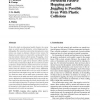2830 search results - page 510 / 566 » Grammar-based robot control |
ALIFE
2000
13 years 9 months ago
2000
The evolution of simulated robots with three different architectures is studied in this article. We compare a nonmodular feed-forward network, a hardwired modular, and a duplicatio...
CEC
2009
IEEE
14 years 4 months ago
2009
IEEE
— Legged robots show promise for complex mobility tasks, such as navigating rough terrain, but the design of their control software is both challenging and laborious. Traditional...
ATAL
2003
Springer
14 years 3 months ago
2003
Springer
Decentralized control of a cooperative multi-agent system is the problem faced by multiple decision-makers that share a common set of objectives. The decision-makers may be robots...
ICRA
1999
IEEE
14 years 2 months ago
1999
IEEE
A high performance six degree-of-freedom magnetic levitation haptic interface device has been integrated with a physically-based dynamic rigid-body simulation to enable realistic ...
IJRR
2002
13 years 9 months ago
2002
We describe simple one-dimensional models of passive (no energy input, no control), generally dissipative, vertical hopping and oneball juggling. The central observation is that i...

